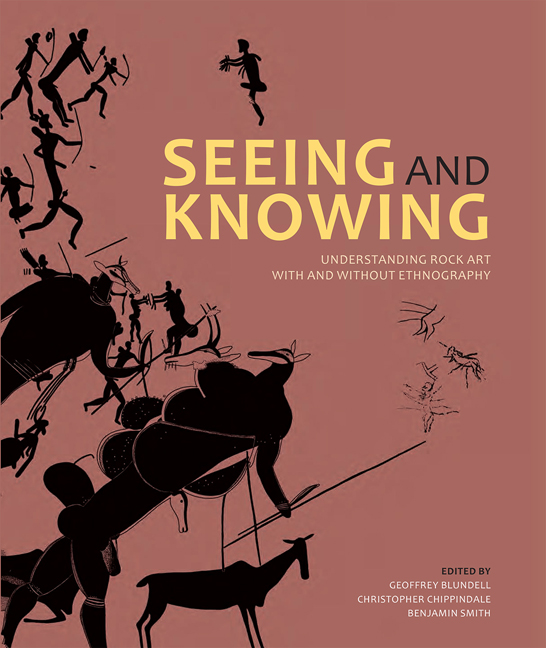Book contents
- Frontmatter
- Dedication
- Contents
- Contributors
- Acronyms
- Chapter 1 Rock art with and without ethnography
- Chapter 2 Flashes of brilliance: San rock paintings of heaven's things
- Chapter 3 Snake and veil: The rock engravings of Driekopseiland, Northern Cape South Africa
- Chapter 4 Cups and saucers: A preliminary investigation of the rock carvings of Tsodilo Hills, northern Botswana
- Chapter 5 Art and authorship in southern African rock art: Examining the Limpopo-Shashe Confluence Area
- Chapter 6 Archaeology, ethnography, and rock art: A modern-day study from Tanzania
- Chapter 7 Art and belief: The ever-changing and the never-changing in the Far west
- Chapter 8 Crow Indian elk love-medicine and rock art in Montana and Wyoming
- Chapter 9 Layer by layer: Precision and accuracy in rock art recording and dating
- Chapter 10 From the tyranny of the figures to the interrelationship between myths, rock art and their surfaces
- Chapter 11 Composite creatures in European Palaeolithic art
- Chapter 12 Thinking strings: On theory, shifts and conceptual issues in the study of Palaeolithic art
- Chapter 13 Rock art without ethnography? A history of attitude to rock art and landscape at Frøysjøen, western norway
- Chapter 14 ‘Meaning cannot rest or stay the same’
- Chapter 15 Manica rock art in contemporary society
- Chapter 16 Oral tradition, ethnography, and the practice of north American archaeology
- Chapter 17 Beyond rock art: Archaeological interpretation and the shamanic frame
- List of figures
- List of tables
- List of publications by david Lewis-williams
- Index
Chapter 13 - Rock art without ethnography? A history of attitude to rock art and landscape at Frøysjøen, western norway
Published online by Cambridge University Press: 21 April 2018
- Frontmatter
- Dedication
- Contents
- Contributors
- Acronyms
- Chapter 1 Rock art with and without ethnography
- Chapter 2 Flashes of brilliance: San rock paintings of heaven's things
- Chapter 3 Snake and veil: The rock engravings of Driekopseiland, Northern Cape South Africa
- Chapter 4 Cups and saucers: A preliminary investigation of the rock carvings of Tsodilo Hills, northern Botswana
- Chapter 5 Art and authorship in southern African rock art: Examining the Limpopo-Shashe Confluence Area
- Chapter 6 Archaeology, ethnography, and rock art: A modern-day study from Tanzania
- Chapter 7 Art and belief: The ever-changing and the never-changing in the Far west
- Chapter 8 Crow Indian elk love-medicine and rock art in Montana and Wyoming
- Chapter 9 Layer by layer: Precision and accuracy in rock art recording and dating
- Chapter 10 From the tyranny of the figures to the interrelationship between myths, rock art and their surfaces
- Chapter 11 Composite creatures in European Palaeolithic art
- Chapter 12 Thinking strings: On theory, shifts and conceptual issues in the study of Palaeolithic art
- Chapter 13 Rock art without ethnography? A history of attitude to rock art and landscape at Frøysjøen, western norway
- Chapter 14 ‘Meaning cannot rest or stay the same’
- Chapter 15 Manica rock art in contemporary society
- Chapter 16 Oral tradition, ethnography, and the practice of north American archaeology
- Chapter 17 Beyond rock art: Archaeological interpretation and the shamanic frame
- List of figures
- List of tables
- List of publications by david Lewis-williams
- Index
Summary
ROCK ART AND ETHNOGRAPHY
… the text-like quality of rock art may allow it to outlive the artist's culture and eventually become incorporated into a new, perhaps radically different, culture that succeeds the first, so that there is no necessary connection between the meanings now attributed to it, and its significance to the original artists (Layton 1985: 441).
A central aspect in rock art research is the discussion and application of ethnography in interpretation. In areas of the world such as Africa, Australia and North America, ethnographic knowledge exists which may be linked, at least in some form, to rock art (e.g. Deacon & Dowson 1996; Katz et al. 1997; Whitley et al. 1999; Chippindale et al. 2000; Stoffle et al. 2000). Study of rock art from the later European prehistoric periods prevents the use of ‘informed’ sources1 linked, directly or indirectly, to the makers or users of rock art; in this sense we deal with ‘rock art without ethnography’. I have elsewhere considered this problem in regard to rock art in western Norway, noting that it is “entirely prehistoric, leaving us no direct clues as to its meaning, and without the means to study it through any informed method” (Walderhaug 1998: 285). Working with this art I have consequently applied a combination of formal and analogical approaches. In this chapter I will not concern myself with formal methods, but rather consider methods of rock art study that depend on use of ethnography in some form – through informed sources or the use of analogy.
Much rock art of the former colonial world was produced well into the ‘historic’ period, but representatives of imperial powers seldom recorded information pertaining to its use and meaning. The meanings of prehistoric images are often enigmatic: the hook-like images found in western Norwegian Stone Age rock art (Figure 13.1) or the Copper and Bronze Age halberds depicted in the engravings of Alpine Mont Bego are clearly laden with meaning lost to us through lack of informed sources. Rock art found in historic contexts can still be puzzling; alongside prehistoric halberds on Alpine sites are both Christian motifs, which we think we know the meanings of, and other shapes in medieval rock art that remain puzzling to us.
- Type
- Chapter
- Information
- Seeing and KnowingUnderstanding Rock Art With and Without Ethnography, pp. 214 - 239Publisher: Wits University PressPrint publication year: 2010



